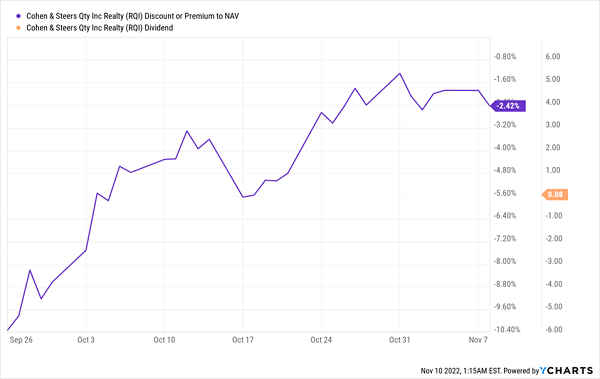Bitcoin price today: gains to $92k ahead of expected Fed rate cut
Despite last week’s market pop, there are still plenty of terrific dividend buys out there. But don’t waste your time with lame payers like General Mills (NYSE:GIS), with its 2.7% yield. Or the miserly 2.2% you get from a so-called “Dividend Aristocrat” like McDonald’s (NYSE:MCD).
Inflation is still at 7.7%! That’s far ahead of these pathetic blue-chip yields. We just can’t afford to own low payers like these any longer.
We need much more income if we want to achieve the dream scenario: a retirement funded entirely by dividends. That’s the path we’re going down today, with three closed-end funds (CEFs) boasting an incredible average yield of 10.5%.
That gets you an “instant” $87.50 per month in dividends on every $10K invested. In other words, you’d need just $677,000 to get $71,000 in yearly income. That’s the median household income in America.
A 10.5% yield is also 10 times more than an index fund pays. Income like that is crucial in selloffs like the 2022 disaster because you won’t have to sell into a downturn, unlike folks who hold the typical S&P 500 name.
Instead, the dividends these three funds pay have kept investors away from the sell button this year. This, over the long haul, is the real key to passive income’s power.
3 CEF Buys for Instant Diversification and 10%+ Dividends
Of course, diversification is critical, so we want our CEF portfolio to hold the following:
- Stocks (for long-term growth)
- Bonds (for stable income)
- Real estate (for a bit of both)
It’s not easy to cobble together a portfolio that ticks all three of these boxes. And if you invest in real estate through physical property, you’re looking at a lot of work. (If you’ve been a landlord, you know it’s a full-time job.)
But you can hit all three categories and get a big income stream with CEFs (with virtually no work!). Here are three funds that, taken together, do just that.
1. A 10.2%-Yielder With a “Hidden” Discount
Let’s start with the Liberty All Star Equity Closed Fund (NYSE:USA), which holds large-cap US companies with strong cash flows and growth potential, like Microsoft (NASDAQ:MSFT), UnitedHealth Group (NYSE:UNH) and Visa (NYSE:V). USA’s managers have also done a nice job of scooping up oversold high-margin firms like Alphabet (NASDAQ:GOOGL), Danaher (NYSE:DHR) and Adobe (NASDAQ:ADBE).
The draw here is the dividend, with USA yielding 10.2%. That dividend comes from payouts on slightly levered stocks in the portfolio, plus returns from management’s timely buys and sells. It’s a strategy that works, with USA posting an outstanding 214% total return in the last decade.
A 'Star-Spangled' Dividend Buy for the Long Haul

We also get a nice “in” courtesy of USA’s valuation. Right now, the fund trades around par (or about the same as the value of the shares in its portfolio). That’s a fair level when you consider that this one has traded at premiums north of 3% in the past year.
2. A 13.4%-Payer That’s Survived Crash After Crash
For bonds, we’ll take the Neuberger Berman High Yield Strategies (NYSE:NHS), which sports a 3.3% discount to NAV. That’s a sweet deal, given that it traded at par as recently as August.
The dividend is truly jaw-dropping, with a 13.4% yield. If you think a payout like that can’t possibly be safe, consider that NHS has kept it rolling in steadily for 10 years, despite the pandemic and rising rates. The reason? A strategic pivot by management toward higher-quality, underpriced corporate bonds.
Those bonds, in particular, give NHS two ways to deliver strong returns: higher income and, over the longer term, gains as they get repriced with improving investor sentiment. This strategy is exactly what we want in this uniquely oversold, but starting to recover, market.
3. An 8%-Yielding Portfolio Any Real Estate Investor Would Envy
Finally, let’s go with the Cohen & Steers Quality Income Realty Fund (NYSE:RQI). The fund has more than 200 holdings, almost all which are real estate investment trusts (REITs). Those REITs, in turn, own hundreds, or even thousands, of properties apiece, so we have zero worries about diversification here.
Top RQI holdings include cell-tower owner American Tower (NYSE:AMT), whose services are in constant demand as mobile-data traffic grows; self-storage REIT Public Storage (NYSE:PSA), which stands to gain from the boom in “stuff” over the past couple years; and warehouse REIT Prologis (NYSE:PLD), which is benefiting as US companies move their manufacturing back home.
REITs’ above-average dividends fuel RQI’s 8% payout, which has held steady for the last five years. With rising rents everywhere, the fund’s income stream is more secure than ever—and investors are taking notice.
RQI’s High Payout Draws a Contrarian Crowd

We’ve seen investors flock to RQI over the last two months, but significantly more upside is on tap as a potential leveling off of rates benefits real estate. I also expect more upside as RQI’s 3.3% discount returns to par—a level at which it’s traded for most of the year.
Put all three of the above CEFs together and you’ve got a 10.5% income stream fully diversified across hundreds of assets in three different classes. That’s a nice setup for 2023, which looks like a much better year overall for the market, but with volatility likely to stick around, too.
Disclosure: Brett Owens and Michael Foster are contrarian income investors who look for undervalued stocks/funds across the U.S. markets. Click here to learn how to profit from their strategies in the latest report, "7 Great Dividend Growth Stocks for a Secure Retirement."
